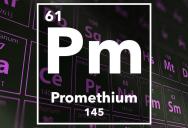Scientists Are Cracking The Promethium Puzzle And Unveiling The Mysteries Of A Rare Earth Element

Promethium, a rare earth element, has been a bit of a mystery in the chemistry world, but scientists are finally unraveling its secrets.
Even though promethium might not be as vital as its neighbors on the periodic table, understanding it better can help us access and utilize the other rare earth elements more effectively.

Promethium is much rarer than other lanthanides because its isotopes have short half-lives, the longest being just 17.7 years.
Over billions of years, natural promethium on Earth has mostly disappeared, leaving only tiny amounts created by cosmic events.
Unlike other lanthanides, promethium has no stable isotopes, making it the last lanthanide discovered and the hardest to study.
Now, the Oak Ridge National Laboratory (ORNL), where promethium was first discovered, has sought to change that.
“The whole idea was to explore this very rare element to gain new knowledge,” said Dr Alex Ivanov in a statement. “Once we realized it was discovered at this national lab and the place where we work, we felt an obligation to conduct this research to uphold the ORNL legacy.” Consequently, the ORNL team is the first to characterize promethium in a solution.
A research team worked with promethium-147, a byproduct of plutonium production. Seemingly inspired by the mythical figure Prometheus, they used organic molecules called diglycolamide ligands to bind with promethium and then measured the bond lengths using X-ray spectroscopy.
They did this with 3+ ions of all the other lanthanides (a group of rare earth elements) for comparison.

Their findings confirmed that promethium experiences “lanthanide contraction,” a phenomenon where electrons are packed more tightly around the nucleus. And why mercury is the only metal that is liquid at room temperature.
With all the other lanthanides experiencing this contraction, it wasn’t a surprise promethium does it too, but the extent of the contraction is not identical for each element.
“The contraction of this chemical bond accelerates along this atomic series, but after promethium, it considerably slows down,” said Ivanov. “Consequently, without measuring the contraction we didn’t know if promethium’s would be more like neodymium to its left or samarium to its right.”
Dr. Santa Jansone-Popova highlighted the importance of this study, saying, “There are thousands of publications on lanthanides’ chemistry without promethium. That was a glaring gap for all of science. Scientists have to assume most of its properties. Now we can actually measure some of them.”
Their study is published as open access in Nature, opening new doors in the understanding of promethium and its rare earth relatives.
So, while promethium might not become the next big thing, cracking its chemical code is a significant step.
If you think that’s impressive, check out this story about a “goldmine” of lithium that was found in the U.S. that could completely change the EV battery game.

Sign up to get our BEST stories of the week straight to your inbox.




